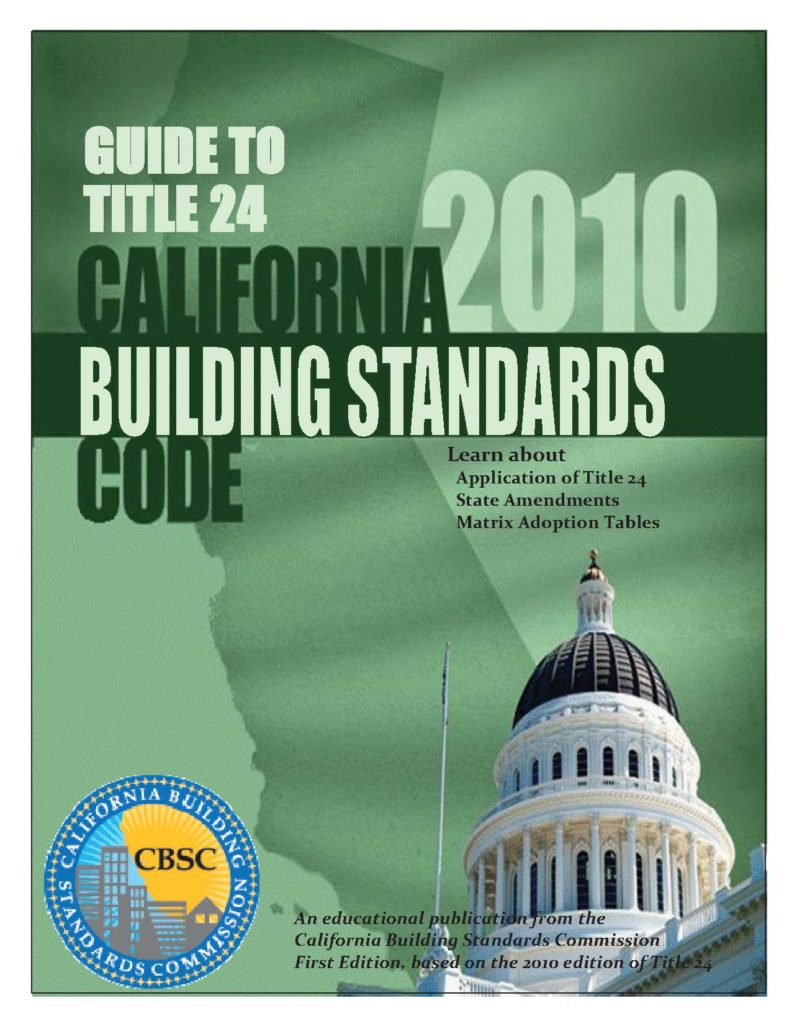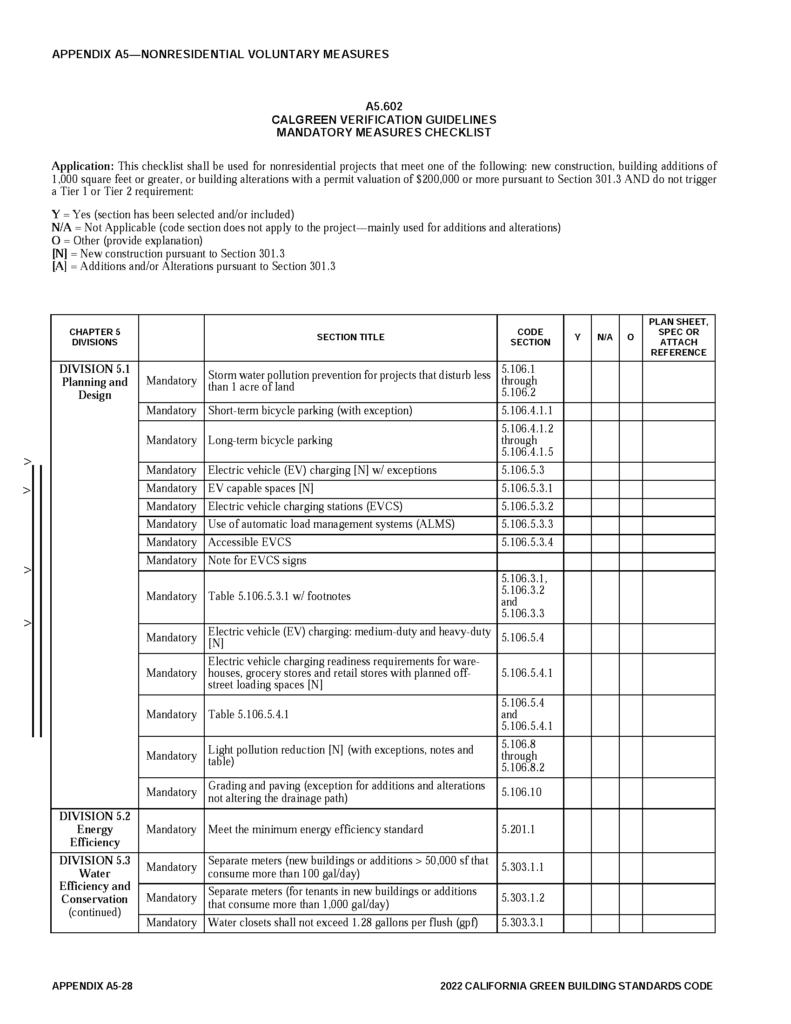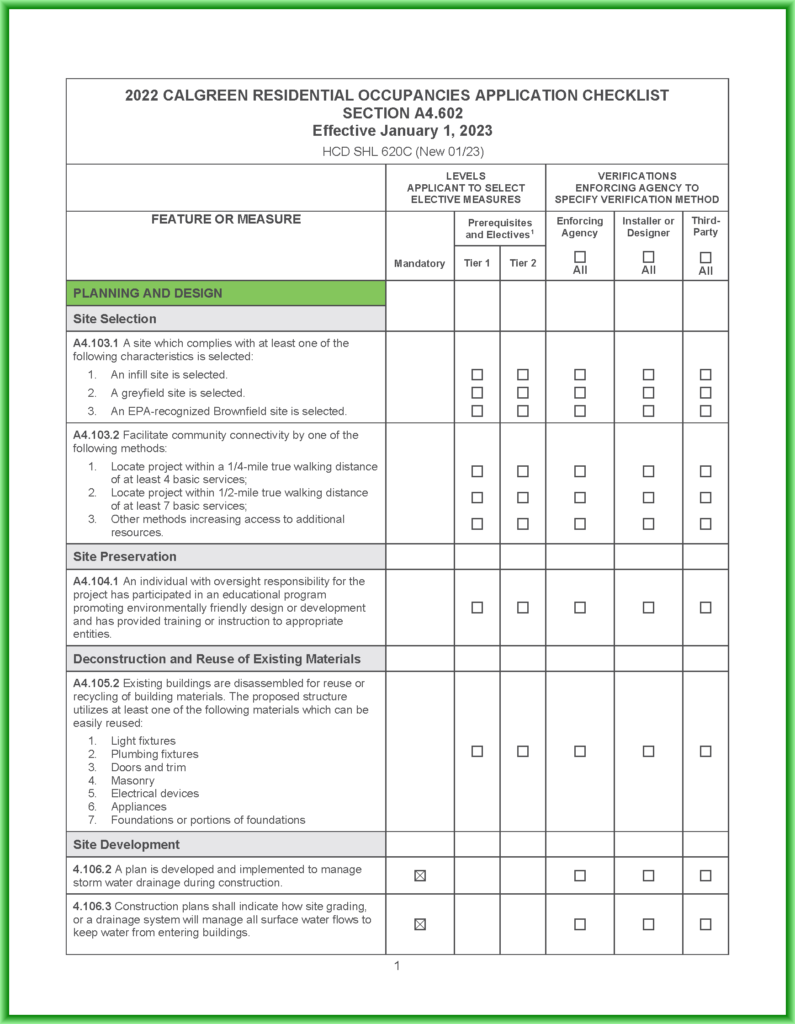CalGreen Code
In 2010 the California Building Standards Commission published the first version of the California Green Building Standards Code. This code name became abbreviated into the CalGreen Code or just “CalGreen”.

The Building Standards Commission describes the intent of the code as follows:
The purpose of this code is to improve public health, safety and general welfare by enhancing the design and construction of buildings. The goal is for positive environmental impact and encouraging sustainable construction practices in the following categories:
-
- Planning and design.
- Energy efficiency.
- Water efficiency and conservation.
- Material conservation and resource efficiency.
- Environmental quality
The code was created to require sustainable building practices into all new buildings in California. It applies to both residential and commercial buildings.
CalGreen includes both mandatory and voluntary measures. Mandatory requirements involve water and energy efficiencies, indoor air quality and the use of sustainable building materials. Voluntary measures, on the other hand, are encouraged to enhance the requirements and/or add sustainable features, such as photo-voltaic solar, high-performance HVAC systems and energy efficient lighting fixtures.
There have been three updates to the CalGreen Code since its inception. The current version is the 2022 code.

The CalGreen Special Inspector
The CalGreen code created a new entity in the building inspection world – the CalGreen Special Inspector. There are many sustainable issues in the code that are outside the experience of many building inspectors. It was for this reason that the California Building Standards Commission created this new position.
CalGreen Special Inspectors must have years of experience in the building design field. They must pass a state exam and commit to recurrent training.
The duties of the CalGreen Special Inspector include verification that the CalGreen requirements are included within the permit documents. In addition, they verify all CalGreen requirements are installed at the end of construction.
In most jurisdictions the CalGreen Special Inspector must sign the final Implementation Verification form which is then submitted to the local building department prior to issuance of the Occupancy Certificate.

The CalGreen Checklist
The new code created another new entity – the CalGreen Checklist. A completed checklist is required to be submitted as part of the building permit application on all new residential and commercial projects. The checklist provides a summary of all the sections of the CalGreen Code that may, or may not, be relevant to your project.
Typically, the architect or CalGreen Consultant will fill out the checklist by marking an “X” in the boxes that are relevant to your project. It is important to understand that checking a box will commit the project to compliance that will later be verified by inspection. It is critical to only check the boxes that the project is absolutely required to comply with.
At CalGreen Energy Services we see many projects that are submitted with unnecessary boxes checked due to the lack of experience with the CalGreen Code. Some of these requirements may burden the project with unnecessary costs, including more expensive materials and costly testing.

CalGreen Tiers 1 and 2
The Tiers of the California Green Building Standards Code allow local building departments to set higher standards for certain sustainable goals.
The Tier 1 optional requirements are more restricted than the basic code requirements and include requirements such as higher energy efficiency goals and reduced water consumption targets.
The Tier 2 requirements up the ante with even higher, or more stringent, sustainable goals than Tier 1.

The Tiers are only mandatory where local ordinances have specifically adopted them. Local adoption varies widely throughout the state. The more progressive jurisdictions have adopted many of the Tier 1 requirements. Few of the local jurisdictions have yet to adopt Tier 2 requirements, though this is to be expected in the near future.
It is important to check with your local building department to see if they have adopted any of the Tier 1 or 2 requirements.
Integrating CalGreen into Your Project
Most projects require the services of a CalGreen Special Inspector. The special inspector must review and sign the CalGreen Checklist before it is submitted as part of the permit documents to the building department.
The special inspector must be notified of any relevant changes to the project during construction to ensure the project remains compliant. The end of the project is no time to learn that the electrical vehicle charging stations that were value-engineered out of the project, are a actually a mandatory part of CalGreen and must be added back! At CalGreen Energy Services we have seen similar situations that have delayed the beneficial occupancy of the building.
The last series of tasks for the CalGreen Special Inspector is the Implementation Verification. The inspector will visit the site and verify that all items included in the approved checklist are installed and properly documented. Once the installation has been verified the inspector will sign the Implementation Verification form which is them submitted to the building department for the Occupancy Certificate.

A Typical Occupancy Permit
While the California Green Building Standards Code can be confusing, the requirements do add value to your project. It is important to have a knowledgeable CalGreen specialist to guide you through the process.
At CalGreen Energy Services we have decades of experience not only in sustainable design, but also in HVAC and Plumbing engineering. This wide range of experience can help ensure your project is not over-committing on your CalGreen requirements.
We respond quickly to emails and voicemails. We will put together a proposal for you right away and can typically start on your project within a couple of days.
Email or call us now to see how we can help you:
Gary Welch
Email: gary@calgreenenergyservices.com
Phone: 707-328-5299
Frequently Asked Questions
What is CalGreen?
CalGreen is an abbreviated reference to the California Green Building Standards Code. The code was first adopted in 2009 and is updated every three years. The code sets minimum requirements for sustainable practices for residential and commercial construction projects throughout the state.
What portions of construction are covered in the CalGreen Code?
The code covers sustainable aspects including site selection, storm water control, water efficiency of fixtures and appliances, electric vehicle charging stations, VOC limits, moisture control, construction waste recycling, indoor air quality and environmental comfort as part of the Mandatory Measures.
What are the Mandatory Measures?
The Mandatory Measures are defined in the CalGreen Code. However, just about every jurisdiction in the state publishes their own list of mandatory measures. Your project must comply with the CalGreen Mandatory Measures adopted by your local building department.
What portions of construction are covered in the CalGreen Code?
The code covers sustainable aspects including site selection, storm water control, water efficiency of fixtures and appliances, electric vehicle charging stations, VOC limits, moisture control, construction waste recycling, indoor air quality and environmental comfort as part of the Mandatory Measures.
What are the CalGreen Tiers?
The code encourages local jurisdictions to raise the sustainable goals by publishing two “voluntary” tiers of additional requirements. They are called Tier 1 and Tier 2. Tier 1 adds additional requirements beyond the mandatory measures. Tier 2 further increases the requirements. The term “voluntary” is somewhat of a misnomer. If your building department has adopted a Tier, it is mandatory for your project, not “voluntary”.
What is the current version of the CalGreen Code?
The current version of the CalGreen Code is the 2022 Green Building Standards Code. The code became effective as of January 1, 2023.
Does CalGreen apply to remodels?
The code applies to remodels that increase the building’s conditioned area, size or volume. The mandatory requirements only apply to the area, or within, the addition or remodel.
Is CalGreen part of Title 24?
No. CalGreen is a separate code called the Green Building Standards Code. “Title 24” is a mis-used synonym for the California Energy Code. The two codes are completely independent of each other. The California Energy Code scope is limited to the energy performance of buildings. The CalGreen code addresses sustainable building practices.
Does CalGreen include requirements for solar panels?
No. Solar panel requirements are covered in the California Energy Code and the California Electrical Code.
Does CalGreen include requirements for electric vehicles?
Yes. The current CalGreen Code has requirements for rough-in for future electric vehicle charging stations for both residential and commercial projects.
What is the CalGreen Checklist?
Most building departments publish their own CalGreen Checklist. The checklist is designed to document that the building design team understands the CalGreen requirements for their project and has included them in the construction drawings/permit plans. Many jurisdictions require a CalGreen Special Inspector sign the CalGreen Checklist to verify that all CalGreen requirements are covered in the permit plans. See the links below for more information on checklists.
Does the contractor have CalGreen obligations during construction?
Yes. The contractor is required to initiate and document the construction waste plan, use only approved VOC containing materials, take moisture readings of construction lumber and provide the building owner with an Operation and Maintenance Manual. Other requirements may apply depending on jurisdiction.
Title 24 Calculations and Documentation
As noted above, Title 24 calculations and documentation are required on all new projects. We do not provide this service. However we frequently partner with a well respected, professional, firm to provide this portion of the project. Delta T Energy provides a full range of California Energy Code and Title 24 compliance documentation and HERS testing. We highly recommend them to our clients. You can learn more about the company here:
https://www.deltatenergyconsulting.com/
Link to the California Building Standards Commission on CalGreen:
http://www.bsc.ca.gov/Home/CALGreen.aspx
2022 CalGreen Non-Residential Mandatory Measures. Note that this is the AIA checklist which is not acceptable in some jurisdictions.
2022 CalGreen Non-Residential Mandatory Measures
2019 HCD CalGreen Residential Mandatory Measures (This is not acceptable in many jurisdictions. Check before using):
2022 HCD Residential Mandatory Measures

